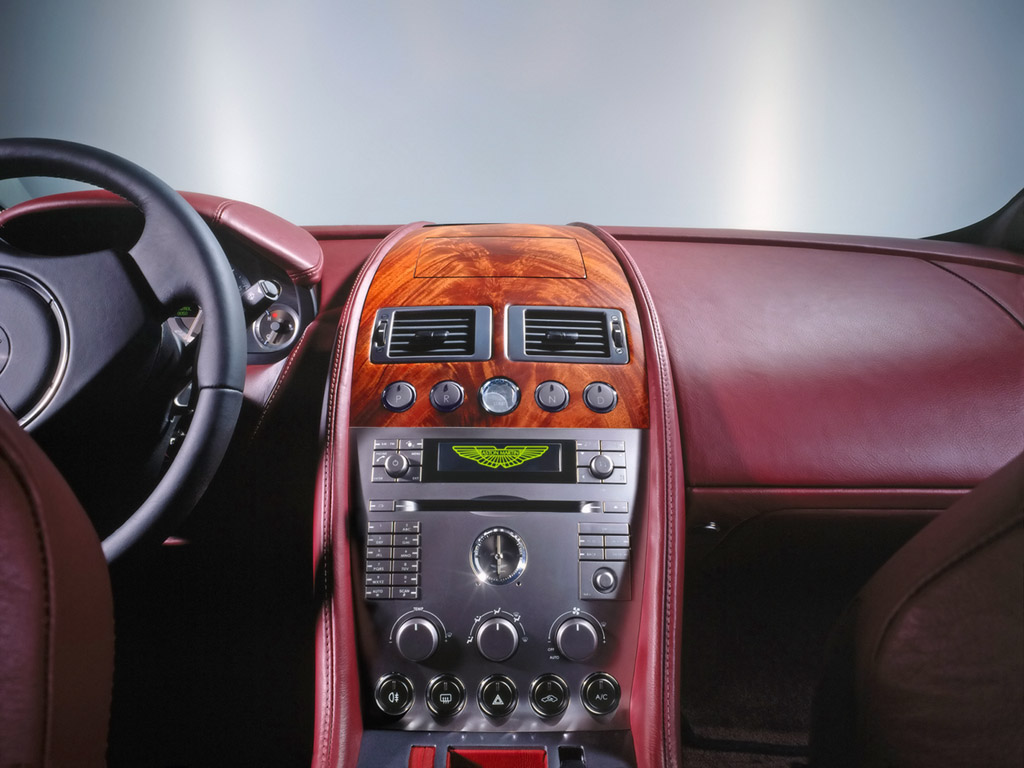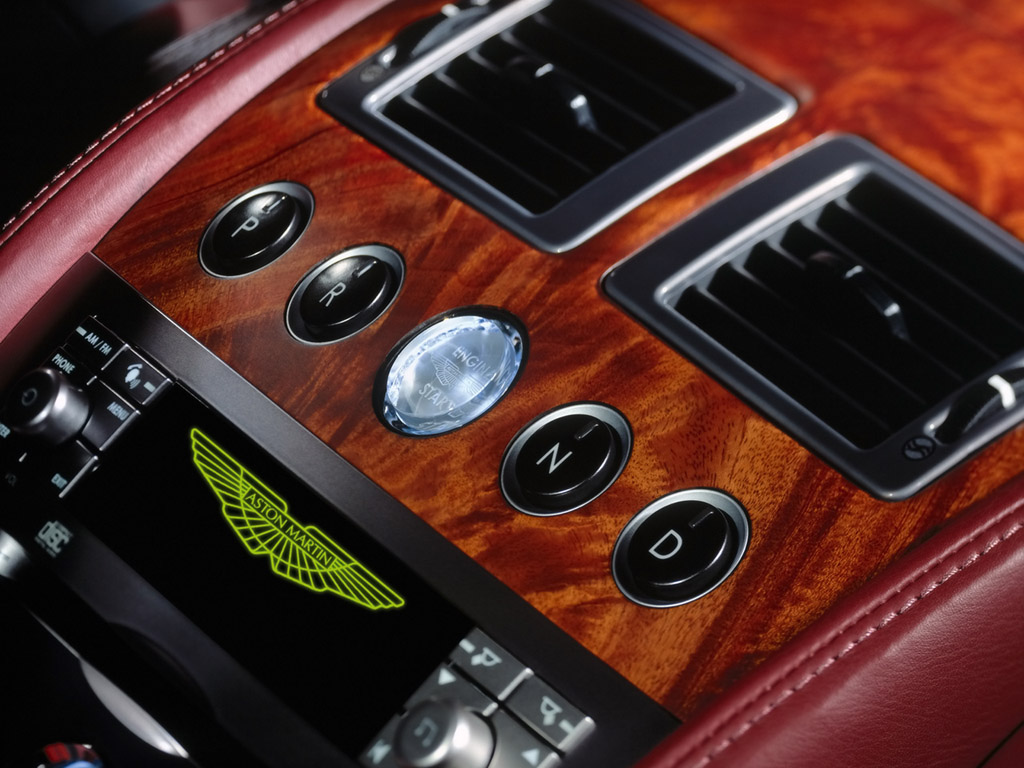Aston Martin DB9
|
Price |
$155,000 |
Production |
-- | ||
|
Engine |
6 liter DOHC V12 |
Weight |
3769 lbs | ||
|
Aspiration |
natural |
Torque |
420 lb-ft @ 5000 rpm | ||
|
HP |
450 @ 6000 rpm |
HP/Weight |
8.4 lbs per hp | ||
|
HP/Liter |
75 hp per liter |
0-100 mph |
10.8 seconds | ||
|
0-60 mph |
4.7 seconds |
Top Speed |
186 mph |
(from Aston Martin Press Release) The future of Aston Martin is epitomised by the all-new DB9, a 2+2 seater sports car that sets new standards in its class due to its astonishing combination of agility, V12 power, smoothness, beautiful design and hand craftsmanship.
Using a radical new
aluminium-bonded body frame, the DB9 is one of the most
sophisticated and
technically advanced sports cars in the world. It is powered by the
latest version of Aston Martin's
6.0-litre V12, producing 450bhp and a top speed of 186mph. Yet the
DB9 is significant well beyond
being a class-leading sports car. It is the beginning of a new era
for Aston Martin. It is the first car
to be hand-made at Aston Martin's new state-of-the-art facility in
Gaydon, Warwickshire, where all
future Aston Martin models will be developed and built.
Sales of the model will
start in Spring 2004, replacing the DB7, the most successful Aston
Martin
in history.
"Gaydon is the future of
Aston Martin," says Dr Ulrich Bez, CEO of Aston Martin. "It combines
cutting-edge high technology with hand-craftsmanship and tradition.
It is probably the best facility
of its type in the world, and the perfect showcase for how to design
and build innovative sports and
GT cars for the 21st Century.
"All cars built at
Gaydon will be based on Aston Martin's new VH [Vertical Horizontal]
platform. It's
the first time in our history that we have had a totally flexible
yet dedicated Aston Martin platform.
The DB9 is the first car to use it making it the most important
Aston Martin ever."
The body frame is the
most structurally efficient in the world, taking into account
strength, torsional
rigidity and weight. It has double the rigidity of many rivals, as
well as being lighter, resulting in
superior handling and agility.
All body panels are
either aluminium or lightweight composites with magnesium being used
on the
steering column and inner door frames. Even the gear selector
paddles are made from magnesium alloy. The total weight is 1710kgs,
extremely light for a V12-powered prestige 2+2 seater sports car
with every imaginable luxury feature. This has a hugely beneficial
effect on performance. Top speed of the manual is 186mph and 0-100
km/h (62mph) acceleration takes just 4.9 seconds. Other
technologically radical features include a ZF 'drive-by-wire'
six-speed automatic gearbox that dispenses with a traditional gear
lever. Instead, the drive, park, neutral and reverse controls are
selected by buttons.
Touchtronic manual mode
enables the driver to change gear using paddles mounted behind the
steering wheel. The automatic gearchange has been tuned to provide
the perfect balance between
super-fast operation and comfortably smooth shifts. A conventional
six-speed manual gearbox will
also be offered.
The agility of the car
is boosted by the perfect 50:50 weight distribution. This has been
achieved
partly by putting the gearbox at the rear. A carbon fibre drive
shaft, running in a cast aluminium
tube, delivers torque from the engine to the gearbox. Handling is
further improved by the light
aluminium wishbone suspension and aluminium bodied dampers. The
whole DB9 cabin is handfinished
in premium quality materials giving it a simple and functional feel.
Aluminium is used in the
interior, reflecting the most commonly used material in the
structure and body. Even details such
as the instrument dials are made from aluminium. Features include
full leather Bridge of Weir
upholstery of the highest quality and a state of the art music
system specially developed for Aston
Martin by British sound experts Linn.
Among the many
technological firsts is the 'message centre' in the dashboard. It is
an organic
electroluminescent display (OEL), as opposed to the more common LCD.
OELs have a higher
resolution and better contrast and are easier to read, especially
when viewed at an angle. Of
course, no Aston Martin would be an Aston Martin without a beautiful
body. The DB9's is modern
and clean but retains much of its heritage. It is a modern
interpretation of a traditional Aston
Martin, the successor to such benchmark designs as the DB4 and DB5.
The aluminium bonnet is
long and extends all the way to the car's leading edge. There is a
minimum number of 'cut' or 'shut'
lines, to aid styling simplicity and beauty.
"The DB9 has been
designed as a sports car but with GT levels of comfort and cruising
ability,"
says Dr Bez. "It is aimed at people who love driving but also enjoy
exclusivity and style.
"It is the perfect
vehicle to take you from London to the south of France, or to drive
for the sheer
exhilaration. It is fun and very focused on the driving experience,
but also offers all the comforts
you would expect from an Aston Martin grand tourer.
"This car is new from
the ground up. We made sure that every solution was the correct one
for the
DB9. This is important for a car that we believe will lead the 2+2
seater sports car class for many
years to come."
The DB9 manages to
combine all facets of style, quality and useability of a traditional
Aston Martin
without relying on retrospective detail or design. It is a totally
modern Aston Martin.



